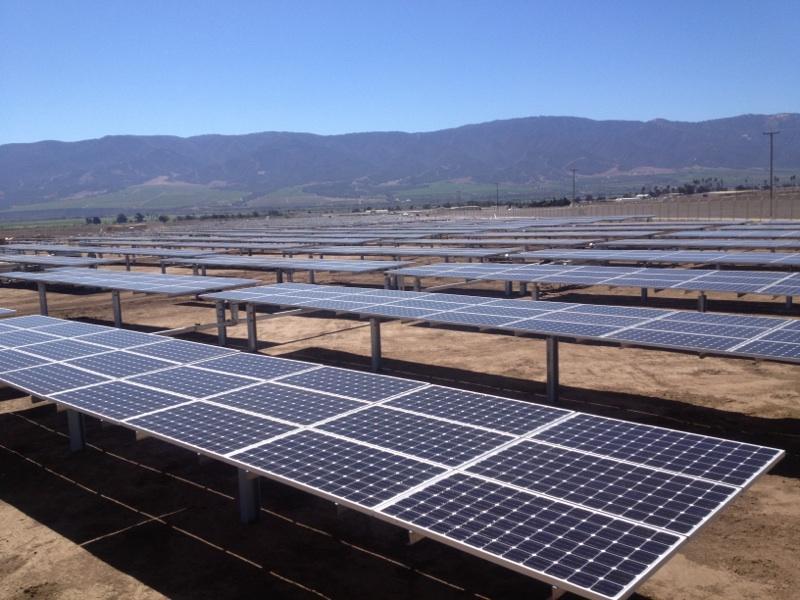Plans call for continuing ambitious sustainability program
CDCR committed to solar projects and renewable energy 15 years ago. In June 2006, a solar power system was installed at Chuckawalla Valley State Prison, providing a cleaner energy source and reducing the burden that CDCR imposes on the power grid. This was just the beginning.
“CDCR is one of the largest departments in State government and over the past decade has been a leader in meeting or exceeding the Administration’s energy and sustainability goals and objectives,” said Deanna Beland, Facility Planning, Construction and Management’s Energy and Sustainability Section Chief. “Through the renewable energy projects now and projected in the near future, CDCR is working toward making California one of the greenest prison systems in the country.”
CDCR plans more solar projects at several prisons in the near future: Installing 2.40 megawatt (MW) solar canopy system at California State Prison, Los Angeles County, 1 MW solar ground mount system at Ironwood State Prison, 2 MW solar ground mount systems at Pleasant Valley State Prison, Chuckawalla Valley State Prison, Correctional Training Facility, and Mule Creek State Prison; 3 MW solar ground mount systems at Richard J. Donovan Correctional Facility, Kern Valley State Prison, and California State Prison, Solano. In addition, a 3.5 MW solar ground mount system is scheduled for Salinas Valley State Prison and a 4 MW solar ground mount system is to be installed at California Correctional Institution in Tehachapi.
CDCR begins solar project at California Men’s Colony
Construction of a 2.5 MW solar project at California Men’s Colony (CMC) began in February 2021. When completed, it is estimated that it will provide approximately 25 percent of the institution’s annual electricity requirements, reduce the load on the local power grid and reduce greenhouse gas emissions by more than 2,700 metric tons annually. This project alone is expected to allow CDCR to save approximately $2 million in utility costs over the next 20 years.
“CMC is committed to operating in a fiscally responsible manner while employing environmentally sound practices during its day-to-day operations,” said CMC Warden (A) Danny Samuel. “The solar project will allow CMC to improve upon its stewardship of taxpayer dollars while protecting California’s natural resources for generations to come.”
The CMC solar arrays will be built at no cost to the state. CDCR’s renewable energy projects are constructed by third-party project developers at their own expense in exchange for CDCR purchasing the electrical power from the renewable energy operators at discounted rates, thus saving California and CDCR millions of dollars over the 20-year term of the Power Purchase Agreements.
In keeping with CDCR’s COVID-19 protocols, which are updated on an ongoing basis, for each new project, the contractor submits a safety plan that limits COVID-19 exposure and their employees attend health and safety training that includes information about proper physical distancing protocols and the use of personal protective equipment and face masks. All contract staff are required to submit to COVID-19 symptom screening, including temperature checks, before entering the jobsite located outside a facility’s secure perimeter.
CDCR Sustainability Program
CDCR has one of the most far-reaching sustainability programs of all state agencies, and has completed more than 100 energy efficiency projects that have yielded an annual cost savings of approximately $9 million. CDCR’s Sustainability Program also includes climate change adaptation, water conservation, organic and green waste diversion, and greening of CDCR’s vehicle fleet through the installation of electric-vehicle charging stations at various facilities statewide.
CDCRs solar and wind turbine projects currently total 59.51 megawatts. Construction of these 12 projects will increase the Department’s renewable energy portfolio to approximately 90 MW, or enough to power approximately 23,000 homes annually, by 2024.
Salinas Valley State Prison and Correctional Training Facility both in Soledad, are already using renewable energy to meet 100 percent of their electricity needs, through a combination of solar panels, wind turbines and green energy purchased from Monterey Bay Community Power.
To date, CDCR is the first and only state department to install wind turbines.
Similar improvements have been made in water efficiency and conservation with a dramatic reduction of water consumption by approximately 40 percent since 2003 (vital during drought years 2013-17).
“Over the past decade, California has experienced extreme variability in yearly precipitation,” says Deanna Beland. “These potential wide swings in precipitation from one year to the next show why California must be prepared for either flood or drought in any given year. CDCR’s on-going water conservation efforts show the department’s commitment to making conservation a California way of life.”
CDCR continually seeks out additional opportunities to decrease its carbon footprint and assess technological advancements in renewable energy. To learn more about CDCR sustainability efforts visit: https://www.cdcr.ca.gov/green/
